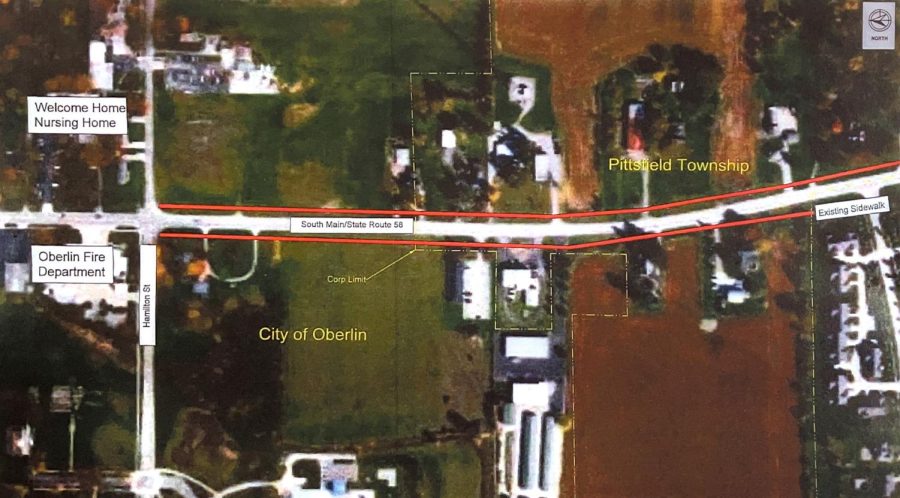Oberlin Crossing Development Supports Land Use Plan Goals
Courtsey of Oberlin Public Works Department
The development of the Oberlin Crossing Shopping Center has sparked much controversy within the Oberlin community.
In The Oberlin Review’s initial coverage of early-stage plans for a shopping center within the city of Oberlin in 2019, an Oberlin resident accused the project’s developers of seeking to “pervert” the City’s Comprehensive Land Use Plan. The “over-riding goal” of sustainability that characterizes the comprehensive plan, which the plans for the shopping center apparently violate, includes maintaining downtown Oberlin as the City’s “traditional commercial core,” as well as protecting other existing commercial areas, “growing sustainable industries,” and “promoting sustainable transportation.” A perhaps secondary but nonetheless important interest of the land use plan is in sustainable, commercial development as a means of generating sources of “future tax-sharing revenues” that will, perhaps, facilitate further measures of sustainability.
I would argue that the Oberlin Crossing Shopping Center, as it has now been named, fulfills rather than violates these express goals for our City. Located at the intersection of Ohio State Route 58 and U.S. Route 20, the shopping center is far enough from the City’s downtown area so as not to challenge its central and uniquely convenient status. The ALDI grocery store, which was the first business to open in the shopping center, is similarly located on the opposite end of the City from the IGA that previously held an especially important role in student grocery-shopping. I doubt that the new ALDI location will substantively detract from the customer base of a business that, while significantly more expensive, has the benefit of being far closer to campus. It will, however, give students who are able to make the commute a far more affordable option to meet their needs.
Another project to be developed in conjunction with the shopping center, called “State Route 58 South — Active Transportation Improvements,” will heighten this impact by constructing a means for residents to bike or walk to the shopping area instead of driving. Such an initiative will not only increase the accessibility of the shopping center to residents without access to cars, but will also expand the store’s market to a key demographic of the town. Even among those who do own cars, the measure will allow for the integration of a more sustainable mode of transportation into their routines. Rather than commuting 13 miles north of town to what had once been the nearest ALDI location or driving to other townships to seek alternatives to the severely limited options previously available in Oberlin, residents will be further encouraged to keep their business in town, resulting in a lower carbon footprint to boot. Such a measure should assuage concerns regarding traffic patterns, too. The option for residents to bike or walk to the location will certainly divert and possibly neutralize whatever increase in car commuters along SR 58 residents expect.
Those who must drive to the store will, therefore, primarily be residents of other townships who choose Oberlin’s location as opposed to others’ for the sake of convenience. The store’s opening will lessen their driving times — and their emissions. It should be noted, too, that these customers, while perhaps accompanied by the apparently unwanted cars that get them to Oberlin, will bring with them their business. This latter benefit is one that is particularly important to Oberlin economically speaking, given the City’s high proportion of tax-exempt properties. Profitable, taxable, commercial businesses such as ALDI — and the others that Oberlin’s City Council will surely be selective in choosing to join it at the shopping center — will be instrumental to the “diverse and stable tax base” that the land use plan seeks to develop. Rather than detract from the City’s other businesses, the success of Oberlin Crossing and the project along SR 58 will together facilitate and contribute to the maintenance of, and perhaps further improvements to, the City’s existing infrastructure.
Therein lies the contradiction of much of the criticisms of Oberlin Crossing, which seem either to presuppose that any new development is inherently threatening to the existing character of the town or to oppose this development because of the mere existence of unspecified alternatives. ALDI and its future neighbors fulfill a need for more affordable, convenient goods for Oberlin residents and encourage more sustainable practices in their shopping. The taxes garnered from these businesses, and from which properties such as those owned by the College are exempt, will support City and School Board operations and, potentially, the means for the very alternative sustainable projects that Oberlin Crossing’s detractors seek to advance. I encourage Oberlin residents to welcome this development as an investment in the town and a vital service that, with time, will fund the rendering of still more services to work toward a more sustainable and accessible town.





